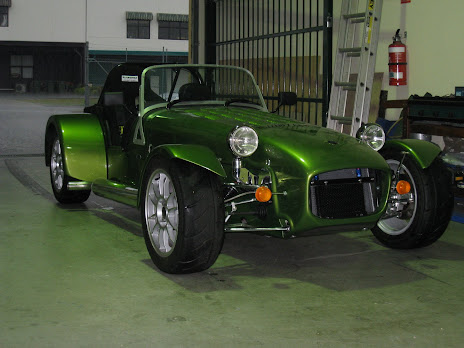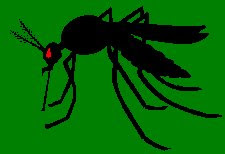The engine build was relatively straight-forward, as it turned out.
 Cam shafts open and close the valves on the top of the engine to allow air into the combustion chamber (through the inlet values), and another set allow exhaust gasses out of the engine (outlet valves). The profile of the cams determines how long the valves are open (duration), and how wide they open (lift). So basically, these two spinning shafts are a key component in the whole process, and need to be matched very, very carefully to the movement of the pistons in the cylinders. Get it slightly wrong, and the cylinders won't get enough air, or be able to push out all of the exhaust, leading to a reduction in power. Get it severely wrong and you can get a cylinder head hitting an open valve, which will break the valve and damage the cylinder head.
Cam shafts open and close the valves on the top of the engine to allow air into the combustion chamber (through the inlet values), and another set allow exhaust gasses out of the engine (outlet valves). The profile of the cams determines how long the valves are open (duration), and how wide they open (lift). So basically, these two spinning shafts are a key component in the whole process, and need to be matched very, very carefully to the movement of the pistons in the cylinders. Get it slightly wrong, and the cylinders won't get enough air, or be able to push out all of the exhaust, leading to a reduction in power. Get it severely wrong and you can get a cylinder head hitting an open valve, which will break the valve and damage the cylinder head.The cams are installed by first placing them into the guides, then measuring the gaps between the buckets and the cam. The bucket is a, well, bucket-like thing that sits over the springs. As the cam turns, the lobe hits the bottom of the bucket, pushing it and the spring downwards, and opening the valve. There needs to be a small gap to ensure the valve is completely closed when the cam is off, but not too much. Each bucket can be moved, as each bucket is very slightly different in height, which allows you to shim up the springs to the correct height.
Then the engine is placed into top dead centre, which is a known position of the engine cylinders. The cams are turned into their correct position by checking the position of the cam and the position of the engine. I won't go into massive detail here, except to say that as mentioned, the cams and cylinders have to be perfectly matched, so that the valves are opened and closed at the correct time.
Refit timing chain and chain guides, and front engine plate
 With everything timed up, the crank (which is driven by the cylinders) and the cams verniers (which turn the cams), must be linked via the timing chain. In most cars, this is a toothed rubber belt, but the Duratec has a chain which is generally more reliable, but needs to be oiled. Hence is it a sealed part of the engine, whereas other cars have their belts external.
With everything timed up, the crank (which is driven by the cylinders) and the cams verniers (which turn the cams), must be linked via the timing chain. In most cars, this is a toothed rubber belt, but the Duratec has a chain which is generally more reliable, but needs to be oiled. Hence is it a sealed part of the engine, whereas other cars have their belts external. The next step is to install the flywheel.
The next step is to install the flywheel.  The flywheel is a heavy metal wheel attached to the engine. The flywheel takes a lot of energy to spin up, which in turn provides a store of energy back to the engine. It's the flywheel that keeps the engine revs from plummeting when you take your foot off the accelerator, and also helps the car climb steep hills. The flywheel is also toothed around the edge - this allows the starter motor to engage with the flywheel to turn the engine when you turn the key.
The flywheel is a heavy metal wheel attached to the engine. The flywheel takes a lot of energy to spin up, which in turn provides a store of energy back to the engine. It's the flywheel that keeps the engine revs from plummeting when you take your foot off the accelerator, and also helps the car climb steep hills. The flywheel is also toothed around the edge - this allows the starter motor to engage with the flywheel to turn the engine when you turn the key.I've opted for a lightweight (relatively speaking) flywheel, as having a lighter flywheel improves acceleration, as there's less rotational mass to spin up. The flywheel is bolted directly to the camshft using some new ARP bolts. Great care was taken, as the manual states they should be done to 175nm, which is actually waaaay too high. Others were stretching their bolts terribly, and were lucky to not snap them off. The manufactures guide, and ARP themselves, stated 100nm which is more realistic.
Once the flywheel is on, the clutch goes on. The clutch comes in two parts - the housing and the clutch plate. The plate is attached to the rear drive train, and is the link between the engine and the rear wheels .With your foot off the clutch, the clutch plate is pressed hard up against the flywheel, and the turning engine turns the wheels. With your foot on the clutch, the clutch slave cylinder pushes outwards, which pressed on the clutch housing. The housing then releases the pressure on the clutch plate, which then lets go of the flywheel. As it's a hydraulic system, the clutch plate progressively engages and disengages with the flywheel.
An important point to note is that the clutch slave cylinder and the clutch housing must be a set distance when the two are brought together. Note that the slave cylinder is installed in the bellhousing, and the clutch on the engine. So you need to measure the distance between the front of the clutch and the front of the engine, and the distance from the front of the bellhousing and the clutch slave cylinder. You can then work out how much travel the clutch cylinder will have, then install a spacer to get it into the right position.
Installing an engine into most cars involves lifting the engine and dropping it into the car. Installing and engine into a Birkin involves lifting the car, and dropping it over the engine. The car at this stage is probably lighter than the whole engine / clutch / gearbox combo anyway, plus it can get a little tight in the engine bay, so this way is a lot easier.

 It was at this point that we discovered a small glitch. The Birkin has a cross member linking the two sides of the car underneath the bellhousing. It's a fairly important crossmember, as it provides a lot of torsional stiffness to the chassis. However, with the 2.0L engine installed, the bellhousing is lower than the bar, which means it doesn't fit. So there's a small job to re-engineer the bar to fit the bellhousing.
It was at this point that we discovered a small glitch. The Birkin has a cross member linking the two sides of the car underneath the bellhousing. It's a fairly important crossmember, as it provides a lot of torsional stiffness to the chassis. However, with the 2.0L engine installed, the bellhousing is lower than the bar, which means it doesn't fit. So there's a small job to re-engineer the bar to fit the bellhousing.The final step in this post is to install the prop-shaft. This links the gearbox to the differential. It also isolates the fixed rear axle from any movement generated in the engine (and vice versa). It does this with two universal joints to isolate up and down movement, plus it slides along the spline from the gearbox for any back and forwards movement.
It's also worth noting that this is a critical failure point in the car - if the propshaft lets go, you then have a very heavy, steel shaft thrashing around mere centimeters from the driver at very high rotational speeds. Hence the two steel hoops there to protect the driver and passenger.



No comments:
Post a Comment